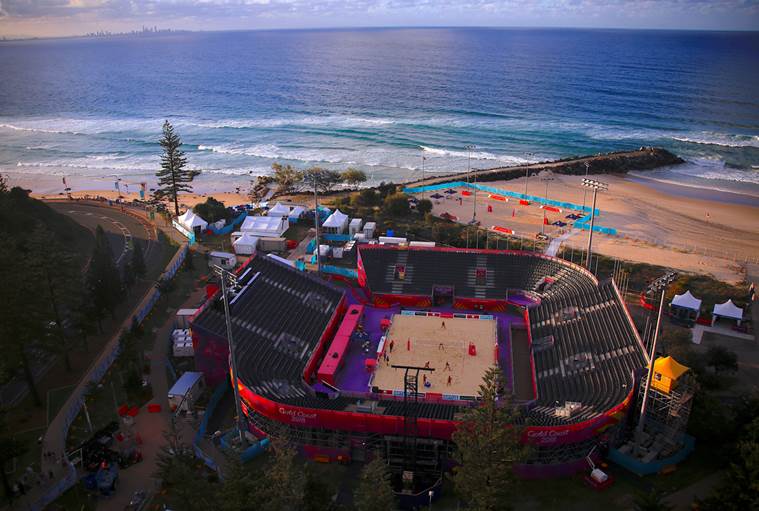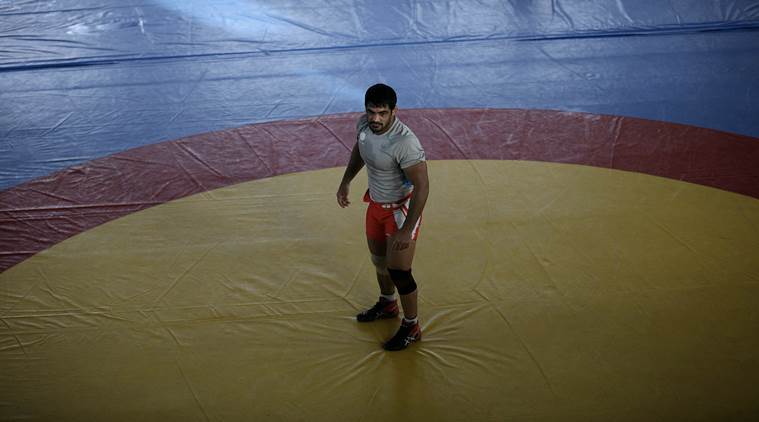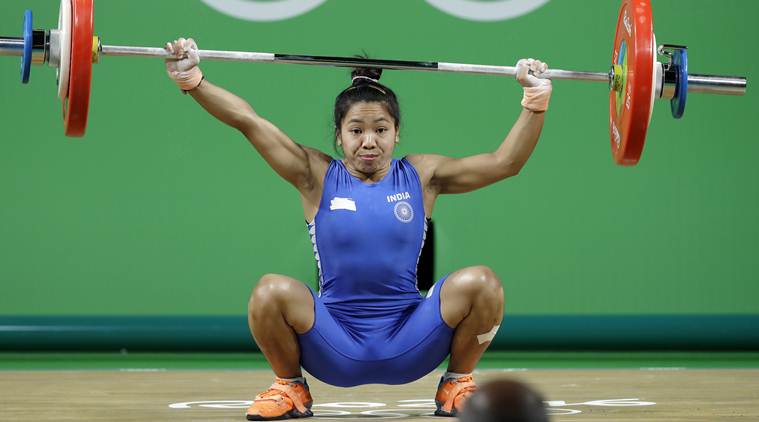 Mature sporting nations use the CWG and Asiad (in certain other disciplines) to test the big-occasion nerves of its youngsters, with a firm eye on the Olympics. (Source: Reuters)
Mature sporting nations use the CWG and Asiad (in certain other disciplines) to test the big-occasion nerves of its youngsters, with a firm eye on the Olympics. (Source: Reuters)
Is double Olympic medallist Sushil Kumar selling himself short by heading to Commonwealth Games for a third easy gold?
Can the inevitable Indian medal glut at Gold Coast in shooting be an accurate reflection of where India’s young and promising shooters stand on the world stage?
Why did weightlifting that grossed India’s second-largest medal count (14) at Glasgow 2014 return with 0 medals from Asian Games two months later and the Olympics, two years on?
In the shimmery sun, sand and surf of Gold Coast – the venue of the Commonwealth Games, the devil is in the details, not the optics. For India, three sports – wrestling, shooting and weightlifting are, once again, expected to rake in a bunch of medals – running in double digits like last time at Glasgow. Many of these could be first-timers, others might well be seasoned pros for whom yet-another CWG medal adds nothing significant to their body of work.
Gold, though, always comes with its caveat of the carat. It is in discerning the value of every medal at the CWG – viewing it through the lens of relative competition, that you could slot these successes either as a stepping stone to bigger triumphs, or the defining climb-up to the pedestal of a podium.
It becomes important to flash this fine print well before the Games, because, in the glut of the gold rush that will start on April 5, it will be easy to dump all perspective and join the revelries of the parade. If lessons are to be drawn from Glasgow four years ago— keeping in mind the thwarting number of just two medals at the Olympics in Rio— then the haul from Australia will need a cold, careful, data-driven look-see, beyond the sweeping appreciation.
***
 Sending Sushil Kumar to the Commonwealth Games is literally bringing out the cannon to kill a fly. (Source: Express File)
Sending Sushil Kumar to the Commonwealth Games is literally bringing out the cannon to kill a fly. (Source: Express File)
Starting with: Why is Sushil Kumar even headed to CWG? Double Olympic medallist, twice CWG gold winner and five-time Commonwealth Championship conqueror, the 34-year-old has nothing to prove amongst grapplers from this same set of nations. The most compelling reason why he’s headed to Gold Coast simply is: because he can.
India’s greatest wrestler earned the right to go by clinching the national trials. But in a weight category that went absurdly unfilled at the Olympics after the notorious (non) face-off with Narsingh Yadav prior to Rio, Gold Coast is nothing but a low-hanging fruit, for Sushil pehlwaan, to pluck. If a second-stringer could’ve secured the gold just as well – given India boasts a rich crop in this division even with Narsingh barred, sending Sushil is literally bringing out the cannon to kill a fly.
The one medal missing from Sushil’s illustrious count is the Asian Games gold which he should seek to win in four months from now. But hindsight is particularly useful when recalling that Sushil’s easy romp to the 74 kg gold after jumping weight divisions, was what muddied the Narsingh debate, even as he skipped a second consecutive Asiad where the Uzbekis and Japanese lie in wait. Sushil would brandish the Glasgow CWG result as his bonafide credentials when staking a claim to trials in the 74kg after Narsingh had won the quota with a World Championship medal. The rider—that it was only a poorly-funded Pakistani pehlwaan he’d beaten in the CWG final—was conveniently forgotten. But Sushil wasn’t the only wrestler. 13 out of 14 grapplers in men and women’s freestyle who went to Glasgow returned with medals—5 gold, 6 silver, 2 bronze, with only Jyoti narrowly missing out, coming fourth.
One way to look at it would be that wrestling is India’s strongest turf at the Commonwealth, a patch to be guarded by maximising medals. The flip-side was the count of 5 medals (1G, 1S, 3B) from 11 entered at the Asian Games at Incheon later in 2014, which ought to have been a reality check for the contingent and pointed to a more accurate picture of what lies ahead in the Olympic competition.
Mature sporting nations use the CWG and Asiad (in certain other disciplines) to test the big-occasion nerves of its youngsters, with a firm eye on the Olympics.
Only two of the 27 medalling nations in wrestling at the Rio Olympics (Canadian 75kg women’s free wrestler Erica Wiebe apart from Indian Sakshi Malik) came from the Commonwealth stock – that’s two medals out of 72. A fifth of India’s Glasgow count (13 of 64) might have come via wrestling, but the net gains at Olympics were just 1 medal – with Sakshi Malik salvaging Rio for the wrestling fraternity with her historic bronze.
“I want to beat the Japanese opponent next,” Sakshi had said recently, setting her targets high. It’s time the country too aimed bigger in 2018 than simply settling for the easy pickings at the Commonwealth.
If not for her, the Bollywood bombast of Dangal —with its exaggerated script that fluffed up an already inflated tale of the Commonwealth Games – might’ve been the only swell news of the last four years. For talented youngsters Divya Kakran and Pooja Dhanda, this will be their first “Games” flush of success, with officials predicting that every Indian is likely to make it to the final. But it would help if their sights are set firmly on Asiad in late August and the next month is viewed in moderation.
***
 Jitu Rai has to swat off ranked contenders who are as far back as world No 61. (Source: File Photo)
Jitu Rai has to swat off ranked contenders who are as far back as world No 61. (Source: File Photo)
The realm of the Commonwealth spans 30 per cent of the world. The number of medals won by Commonwealth shooters at the Rio Olympics was four from a maximum possible of 45. The Empire didn’t include the European gun hubs Italy and Germany, nor are the traditional giants USA, China and Russia or even the second-rung Asian neo-powers Korea and Vietnam.
India boasted of exceptional shooting results in the last decade and half – starting with Rathore’s silver, peaking at Bindra’s gold, consolidated by Vijay and Narang’s two medals in one Games and encompassing the gleeful Golden Finger of Melbourne 2006 CWG Samresh Jung. At Rio, two years after the routine plush haul from Glasgow CWG (17 medals – 4 gold, 9 silver, 4 bronze), India ended with 0.
Only Bindra managed to sustain that run following-up on the Glasgow gold with a 4th place finish at Rio. But the original spring of Indian shooting of the last Olympic cycle – that heralded emergence of names like Jitu Rai, Ravi Kumar, Malaika Goel, Ayonika Paul and Apurvi Chandela – faded so quickly that none came close to stepping it up at Rio.
With no TV beaming the circuit live into homes year-round and minimal name-recall of India’s challengers–the global studs, shooting’s headlines are hardly nuanced in their enunciation. Recent good tidings from Mexico (World Cup) and Sydney (Jr World Cup) where the country’s teens and post-teens shone, are pointing to a start of a good run. But for the likes of Mehuli Ghosh, Anish Barnala, Anjum Moudgil, Neeraj Kumar, Deepak Kumar and Manu Bhaker – the CWG ought to be the starting point of the journey whose destination is Jakarta Asian Games —5460 kms, and 136 days away from Gold Coast.
The sport has gotten visibly younger now, but whether it’s the cent-per-center Elavenil Valarivan (she needed 37 inner 10s plus the perfect score for gold recently to beat back a Taiwanese and Czech who managed the 400 & the 37 separately) or NCC’s cool one-shot Pooja Ghatkar, India will need to keep them all in the mix, and pitch the best ones forward for the 2020 Tokyo Olympics.
Two years post his retirement, Bindra remains India’s top-ranked 10m air rifle shooter, while Ravi Kumar is favourite to win at Gold Coast and Irwan Rahman of Singapore his closest competitor with only 10 of the top 100 coming from CWG nations. The three-position is a narrower elite bunch – barely half a dozen from CWG in the world’s ranked top 100, though legend Kenneth Parr is the name to beat for gold. The air pistol is teeming with Indians (five of the top 10 CWG shooters are Indians) and Jitu Rai has to swat off ranked contenders who are as far back as world No 61. Pistol masters Japan, Vietnam, Ukraine, Serbia, Brazil, China, Korea and Italy will fetch up at Worlds and Asiad later in the year, and that’s where Rai, a bonafide world-beater, ought to be judged.
India is mighty excited about its teen prodigy Anish, and with Neeraj Kumar, the youngest of the Army rapid fire pistol shots, should breeze through the CWG (with just 6 from CWG countries in top 100). But a cursory look at 25m rapid fire pistol hierarchy will throw up the charming French name Jean QuiQuamPoix—a silver medallist at Rio not even a year after his junior world record. CWG, thus, is just a stub of the challenge, a mere scrap compared to the global battle.
It’s in the shotgun events where a Commonwealth Games medal is worth its shine of metal. Professional farmer Edward Ling of England who picked bronze at Rio is one among seven Brits amongst the ranked 100. The Australians are strong on the trap event as are the Kiwis this year, and if there’s a pair of shooters at the CWG who will face the intensity of a near global field, it is Kynan Chenai and Manavjit Singh.
You can’t rule out new names popping up from other countries and sneaking a few medals away from India. But history points to India’s dominance in CWG shooting. What came undone in Rio will need to be mended in Tokyo though. Coasting to golds at Australia ain’t no one’s idea of shooting’s revival.
***
 Mirabai Chanu had first come to attention at the CWG in Glasgow. (Source: Reuters)
Mirabai Chanu had first come to attention at the CWG in Glasgow. (Source: Reuters)
The one name in Indian sport that really made amends for her Rio disappointment was Mirabai Chanu—after she became World Champion last year. However, the pocket sized Girl-Hercules, had first come to attention at the CWG in Glasgow. Sanjita Chanu had ended up with gold, with Mirabai Saikhom three kgs off the gold. In all, India finished with 11 medals— and were upgraded to 12 (3G, 4S, 5B) after a couple of dope positives among other nations.
Where the medals went completely missing was at the Asian Games – an event that experts say tends to get tougher than the Olympics, to medal. The count stayed 0 at both the continental Games and two years later at Rio. While shooting and wrestling sent its largest squads to the Olympics—with athletes putting themselves into position from where they could take a shot at finals—weightlifting met its Waterloo at the 2016 Asian Championship with only the male 77 kg and female 48kg even securing the Rio berth.
The Commonwealth surfeit in lifting didn’t even make the next grade, let alone look like emulating Malleswari’s feat from 16 years ago. Not much has changed for Gold Coast, and India’s strong women and men are expected to again swamp the podiums at Gold Coast.
What’s new though is India fielding more lifters in the higher divisions (men’s 105 kg & women’s 75 and 90 kg), which should open up more avenues at the Asiad in August. Still, the CWG will only be looked at as preps for the stiffer continental challenge, and every medal here might not be its worth its weight in gold.
***
‘The Medal Is Important Because It’s An International Medal’
What is your medal prediction?
SAHDEV YADAV (General Secretary, Indian Weightlifting Federation): We’ll get a lot of gold medals. Last time we got three golds, this time, at least six.
VN PRASOOD (General Secretary, Wrestling Federation of India): In all weight categories, over men and women, we will all get medals. Last time only one didn’t get. This time, all wrestlers will enter the final. We can get ‘total’ medals. No doubt.
ASHOK PANDIT (Vice President, National Rifle Association of India): Commonwealth Games we will be dominating, that’s why they want to get shooting out of the event from 2022. Because we always win at it.
How is competition as compared to Asiad and Olympics?
SAHDEV YADAV: CWG doesn’t have that tough competition in weightlifting.
VN PRASOOD: Canada and Nigeria have Olympic medallists. They are good, but only in some weight classes. In CWG, competition in wrestling is not so good because there aren’t many Commonwealth countries that are good at wrestling. But some Russian wrestlers have migrated to Australia, so they can be competitive as well.
ASHOK PANDIT: It depends on certain events. In the shotgun category, we aren’t that highly ranked so it’s not easy for our players to win. But in the pistol and rifle, the competition is not great, and our standard there is much higher than the Commonwealth standard, so we dominate.
What is the true value of a CWG medal?
SAHDEV YADAV: The calendar is such that the Commonwealth Games comes first, so it can be used to prepare for the Asian Games. To win a medal at the Asian Games is very tough. By winning a medal at CWG, you also get some momentum and see how practice is going.
VN PRASOOD: The medal is also important because it is an international medal at the end of the day. But the Asian Games medal is much tougher to win.
ASHOK PANDIT: If you compare it to the Asian level, it’s not that high level. But it varies from event to event. At the end of the day, it is a game with good prize money. So there is some pressure. But for juniors, it’s a good international experience before the big senior events. For a senior, you can’t rest on past laurels. Even if there isn’t much international competition, you have pressure from your own countrymen. So winning gold is still not that easy.
Where do the Asian Games stand?
SAHDEV YADAV: Asian Games has Thailand and China. Asian countries are the main ones in weightlifting. Asian Games medals equal the Olympics. This time we should get at least two medals at the Asian Games, and even at the Olympics. Mirabai Chanu has got a gold medal at the 2017 World Championship (48 kg) beating score of what the Olympic silver medallist got at Rio by two kgs (clean and jerk).
VN PRASOOD: There are big Olympic prospects that come for the Asian Games. Iran, China, Kyrgyzstan, Japan, Uzbekistan, they’re all there. All the former Soviet countries that are now in Asia are big. So the standard in Asia is high. But the Indian team is also one of the big players in the Asian and Olympic field now.
ASHOK PANDIT: Definitely a more prestigious medal, and definitely much tougher to win. Like we dominate at the Commonwealth Games, we can’t dominate the Asian Games. Korea, China, and Thailand in some events, it’s really tough competition.